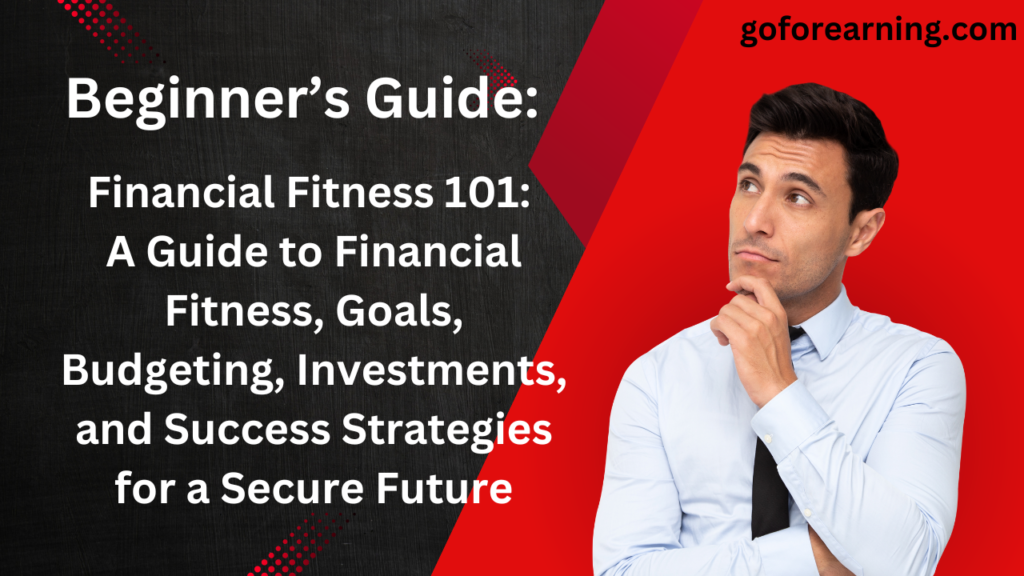In this insightful guide, discover practical strategies and proven methods to boost your financial fitness and achieve long-term economic well-being. Explore key principles of financial management, including budgeting, saving, and investing, to lay a solid foundation for a secure financial future.
“Saving money is not about what you lose; it’s about what you gain in financial peace.” – Ethan Peacekeeper
Introduction
Good money management skills and well-informed choices are key to improving your financial fitness. Improving your financial fitness involves adopting healthy financial habits and making strategic decisions to manage your money wisely. Here are some practical steps to enhance your financial well-being:
“Every dollar saved is a vote for your financial independence. Cast it wisely.” – Zoe Independentwise
How can I improve my financial fitness?
Make a spending plan
- Careful Record-Keeping: Write down all of your income and expenses. To simplify this process and keep track of your spending, use tools or apps.
- Review Your Budget Regularly: Make sure your budget is still in line with your financial goals by reviewing it often. Change as needed to account for changes in spending or income.
Back-up Fund
- Calculating Expenses: Make a list of all the things you need to pay each month to live, like rent or mortgage, energy, food, insurance, and loan payments.
- Contributions That Keep Coming: Set up your bank to send money to your disaster fund every month. Every little bit helps in the long run.
Get out of debt
- High-Interest First: Pay off the bills with the highest interest rates first to save money on interest over time.
- Consolidation: Look into your choices for consolidating your debt to make payments easier and maybe even lower your interest rates.
Spend and Save
- Clear Goals: Write down your short- and long-term money goals. Give each goal a certain amount of money.
- Diversification: To lower your risk, put your money into a variety of things, such as stocks, bonds, and real estate.
Planning for retirement
- Maximize Contributions: To get the most out of compound interest, put the most money into your savings accounts as possible.
- Read Over and Over: Check your retirement plan often to make sure it fits with your financial goals and make changes as needed.
Learn something
- Always learning: Know about changes in tax rules, business techniques, and money management.
- Professional Advice: You might want to talk to a financial advisor to get advice that is tailored to your specific needs.
Coverage for insurance
- Check for Adequacy: Look over your insurance policy often to make sure it’s protecting your assets and family well.
- Health and Life Insurance: Read over the terms of your health and life insurance plans to make sure they still meet your needs.
Do not spend more than you can afford

- Living Cheaply: Choose to live a cheap life by being smart about how much you spend. Separate your needs from your wants to avoid spending money you don’t need to.
- Emergency Budgeting :When making an emergency budget, it’s important to have a backup plan for unplanned costs and not depend on credit cards.
Smart Ways to Negotiate and Shop
- Comparison shopping: Look into prices and compare deals before you buy something big.
- Negotiation Skills: Get better at negotiating, especially when it comes to costs that you have to pay every month, like interest rates or energy bills.
Always Getting Better
- Thoughts: Think about your money habits and how you’re doing in reaching your goals on a regular basis.
- Adaptation: As things in your life change, so should your cash plan. Be adaptable and change your plans as needed.
Get help from a professional
- Make a Smart Pick: When you need financial help, only talk to licensed and trusted experts. Know how they work and how much they charge.
- Checking in often: Set up regular meetings with your financial advisor to go over your plan again.
How to Get and Keep Good Credit
- Payments on Time: To keep your credit score high, pay all of your bills on time every month.
- Credit Report Monitoring: Check your credit report for mistakes on a regular basis and fix any problems right away.
By making these changes to the way you handle your money, you’ll lay the groundwork for long-term financial health and security. Keep in mind that getting financially fit is an ongoing process that needs constant attention and change.
“Saving money is not a task; it’s a journey towards financial empowerment.” – Liam Empowerwise
Emergency Fund Essentials
Why is having an emergency fund important?
An emergency fund is a financial safety net that provides a cushion in times of unexpected expenses or financial setbacks. Here’s why having an emergency fund is essential:
1. Financial Security:
- Importance: An emergency fund offers financial security by covering unforeseen expenses, such as medical bills, car repairs, or sudden job loss, without relying on credit or loans.
2. Stress Reduction:
- Importance: Having a financial safety net reduces stress and anxiety associated with unexpected financial challenges. It provides peace of mind knowing you have resources to handle emergencies.
3. Avoiding Debt:
- Importance: An emergency fund helps you avoid accumulating high-interest debt when faced with unexpected expenses. It acts as a buffer, preventing the need to rely on credit cards or loans.
4. Maintaining Financial Goals:
- Importance: With an emergency fund, you can stay on track with your long-term financial goals without being derailed by sudden financial setbacks.
5. Opportunity for Flexibility:
- Importance: An emergency fund provides flexibility in decision-making. It allows you to make choices based on your priorities rather than being forced into immediate financial decisions.
How to Build and Maintain a Sufficient Emergency Fund?
1. Set a Realistic Goal:
- Tip: Based on your monthly spending, determine how much you need in your emergency fund. Aim for a minimum of three to six months of living costs.
2. Start Small and Be Consistent:
- Tip: If starting from scratch, begin by setting aside a small amount regularly. Consistency is key, even if it’s a modest contribution each month.
3. Automate Savings:
- Tip: Set up automatic transfers to your emergency fund. This ensures that a portion of your income goes directly into your savings account before you have a chance to spend it.
4. Cut Unnecessary Expenses:
- Tip: Identify non-essential expenses in your budget and allocate those funds to your emergency fund. Cutting back on discretionary spending accelerates the growth of your safety net.
5. Use Windfalls Wisely:
- Tip: Direct unexpected windfalls, such as tax refunds or bonuses, toward your emergency fund. This allows you to make substantial contributions without impacting your regular budget.
6. Prioritize Emergency Fund Contributions:
- Tip: Treat contributions to your emergency fund as a non-negotiable expense. Prioritize it alongside other essential bills to ensure consistent saving.
7. Review and Adjust:
- Tip: Regularly review your financial situation and adjust your emergency fund goal if necessary. Life circumstances change, and your safety net should reflect these changes.
8. Separate Emergency Fund from Daily Accounts:
- Tip: Keep your emergency fund in a separate account to reduce the temptation to dip into it for non-emergencies. This separation reinforces the fund’s designated purpose.
9. Consider High-Interest Savings Accounts:
- Tip: Explore high-interest savings accounts to maximize the growth of your emergency fund. These accounts typically offer better interest rates than standard savings accounts.
10. Replenish After Using:
- Tip: If you need to use your emergency fund, make it a priority to replenish it as soon as possible. This ensures your financial safety net is ready for future unforeseen expenses.
11. Assess and Update Regularly:
- Tip: Periodically assess your living expenses and adjust your emergency fund goal accordingly. Life changes, such as a new job or family addition, may impact your financial needs.
12. Emergency Fund vs. Investments:
- Tip: Keep your emergency fund separate from investments. While investments offer growth potential, an emergency fund should be easily accessible without the risk of market fluctuations.
13. Educate Family Members:
- Tip: Ensure that family members are aware of the emergency fund’s purpose and the importance of preserving it for genuine emergencies.
14. Emergency Fund for Specific Goals:
- Tip: Consider creating separate emergency funds for specific goals, such as medical emergencies, home repairs, or job loss. This allows you to allocate funds strategically.
Creating and keeping an emergency fund takes discipline and smart preparation.By consistently saving and adapting to changing circumstances, you can establish a robust financial safety net that provides security and peace of mind in times of need.
Smart Shopping Strategies
Utilizing Discounts, Coupons, and Loyalty Programs
1. Sign Up for Loyalty Programs:
- Tip: Join loyalty programs offered by retailers and brands to earn points, discounts, or exclusive offers on future purchases.
2. Use Coupons and Promo Codes:
- Tip: Look for coupons and promo codes before making online or in-store purchases. Websites and apps like RetailMeNot or Honey can help you find discounts.
3. Cashback and Rebate Apps:
- Tip: Use cashback apps like Rakuten or Ibotta to earn cash back on qualifying purchases. Check for cashback offers before making a purchase.
4. Take Advantage of Student or Military Discounts:
- Tip: If you’re a student or part of the military, inquire about discounts at retailers, restaurants, and entertainment venues. Many establishments offer special rates.
5. Wait for Sales and Clearance Events:
- Tip: Be patient and time your purchases with sales events, clearance sales, or seasonal promotions to get items at discounted prices.
6. Compare Prices Online:
- Tip: Before making a purchase, compare prices across different online retailers. Use comparison websites or browser extensions for quick price checks.
7. Stack Discounts and Rewards:
- Tip: Combine discounts, coupons, and loyalty rewards to maximize savings. Some retailers allow you to stack multiple offers for a single purchase.
8. Follow Brands on Social Media:
- Tip: Follow your favorite brands on social media for exclusive announcements, promotions, and limited-time discounts.
9. Participate in Referral Programs:
- Tip: Take advantage of referral programs that reward you for recommending products or services to friends and family.
10. Membership Discounts:
- Tip: Explore membership programs or discount clubs that offer exclusive savings for their members. This could include wholesale clubs or subscription services.
Making Informed Purchasing Decisions to Save Money
1. Research Before Buying:
- Tip: Read reviews, compare features, and research products before making a purchase. Informed decisions can prevent impulse buying and ensure satisfaction.
2. Buy Generic Brands:
- Tip: Consider opting for generic or store-brand products instead of name brands. They often provide similar quality at a lower cost.
3. Take Advantage of Price Matching:
- Tip: Some retailers offer price matching, where they match a competitor’s lower price. Before making a purchase, ask about this policy.
4. Wait for Off-Peak Seasons:
- Tip: Timing matters. Consider making significant purchases during off-peak seasons or when demand is lower to secure better deals.
5. Evaluate Long-Term Costs:
- Tip: Consider the long-term costs associated with a purchase, such as maintenance, upgrades, or subscription fees. Sometimes a higher upfront cost may lead to lower overall expenses.
6. Check Return Policies:
- Tip: Review the return policies of the stores you frequent. Knowing the return terms can save you money and hassle in case you need to return a purchase.
7. Consider Second-Hand or Refurbished Items:
- Tip: Explore second-hand markets, thrift stores, or refurbished items for cost-effective alternatives, especially for items like electronics or furniture.
8. Bundle Purchases:
- Tip: Bundle similar purchases to take advantage of bulk discounts or free shipping offers. This is particularly effective for online shopping.
9. Negotiate Prices:
- Tip: In certain situations, especially for big-ticket items, don’t hesitate to negotiate the price. This is more common in industries like furniture or electronics.
10. Be Mindful of Impulse Purchases:
- Tip: Pause and think before making impulse purchases. Consider whether the item is a need or a want, and whether it aligns with your budget.
By incorporating these smart shopping strategies, you can make more informed purchasing decisions, save money, and maximize the value of your budget. Remember that a thoughtful approach to shopping can lead to long-term financial benefits.
Investing in Your Future: A Guide to Long-Term Investments
Investing in your future involves making strategic decisions that can yield financial growth and security over an extended period. Long-term investments are a key component of this strategy. Unlike short-term investments, which may experience fluctuations, long-term investments aim to capitalize on compound growth and market trends over an extended horizon.
Tips for Selecting Suitable Investment Options Based on Risk Tolerance:
1. Understand Your Risk Tolerance:
- Tip: Before investing, assess your comfort level with risk. Consider factors such as financial goals, time horizon, and emotional resilience to market fluctuations.
2. Diversify Your Portfolio:
- Tip: Spread your investments across different asset classes, such as stocks, bonds, and real estate. Diversification helps mitigate risk and enhance overall portfolio stability.
3. Define Your Investment Goals:
- Tip: Clearly define your financial goals and the purpose of your investments. Whether it’s saving for retirement, a home, or education, align your investment strategy with your specific objectives.
4. Consider a Mix of Assets:
- Tip: Depending on your risk tolerance, create a balanced portfolio that includes both growth-oriented assets (e.g., stocks) and income-generating assets (e.g., bonds). This can provide stability and potential for capital appreciation.
5. Research and Stay Informed:
- Tip: Stay informed about market trends, economic indicators, and potential risks. Examine your investments on a frequent basis to ensure they are consistent with your financial goals.
6. Invest in Retirement Accounts:
- Tip: Take advantage of tax-advantaged retirement accounts such as 401(k)s or IRAs. These accounts offer tax benefits and are designed to support long-term retirement savings.
7. Explore Index Funds and ETFs:
- Tip: Consider low-cost index funds or exchange-traded funds (ETFs) that track market indices. These passive investments provide broad market exposure and are known for their cost-effectiveness.
8. Assess Time Horizon:
- Tip: Longer time horizons allow for a more aggressive investment approach. If your financial goals are several years away, you may have the flexibility to withstand short-term market fluctuations.
9. Reinvest Dividends and Returns:
- Tip: Reinvesting dividends and returns compounds your investment growth over time. This strategy leverages the power of compounding to accelerate wealth accumulation.
10. Review and Adjust Periodically:
- Tip: Regularly review your investment portfolio to ensure it remains aligned with your financial goals. Adjustments may be necessary based on changes in your life circumstances or market conditions.
11. Seek Professional Advice:
- Tip: If unsure about your investment strategy, consider consulting with a financial advisor. A professional can provide personalized guidance based on your individual financial situation and goals.
12. Emergency Fund and Short-Term Savings:
- Tip: Before delving into long-term investments, ensure you have an adequate emergency fund and short-term savings. This safeguards against the need to liquidate long-term investments during unexpected expenses.
13. Avoid Emotional Decision-Making:
- Tip: Emotional reactions to market volatility can lead to impulsive decisions. Maintain a disciplined approach and avoid making investment decisions based solely on short-term market fluctuations.
14. Stay Disciplined During Market Fluctuations:
- Tip: Markets may experience ups and downs. Stay disciplined and avoid making hasty decisions during periods of volatility. Long-term investments are designed to withstand market fluctuations.
15. Review Fees and Expenses:
- Tip: Be mindful of investment fees and expenses. High fees can erode returns over time, so opt for low-cost investment options whenever possible.
Remember, successful long-term investing involves a strategic and disciplined approach. By aligning your investments with your risk tolerance, financial goals, and time horizon, you can build a portfolio that has the potential to grow and secure your financial future. Regular monitoring and adjustments ensure your investment strategy remains in line with your evolving needs and market conditions.





